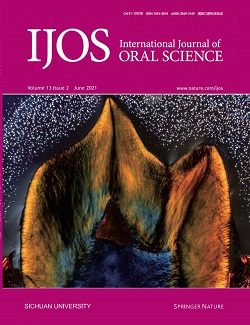Thymosin α1 alleviates pulpitis by inhibiting ferroptosis of dental pulp cells.
IF 12.2
1区 医学
Q1 DENTISTRY, ORAL SURGERY & MEDICINE
引用次数: 0
Abstract
Tooth pulpitis is a prevalent oral disorder. Understanding the underlying mechanisms of pulpitis and developing effective treatment strategies hold great significance. Ferroptosis has recently emerged as a new form of cell death, but the role of ferroptosis in pulpitis remains largely unknown. In our study, single-cell RNA sequencing (scRNA-seq) was used to identify cellular heterogeneity between 3 pulpitis tissue and 3 healthy pulp tissue, and explored ferroptosis occurrence in pulpitis tissue and inflamed dental pulp cells (DPCs). In scRNA-seq, 40 231 cells (Pulpitis: 17 814; Healthy pulp: 22 417) were captured, and visualized into 12 distinct cell clusters. Differentially expressed ferroptosis-related genes (DE-FRGs) were almost presented in each cluster in pulpitis vs healthy pulp. ROS and Fe2+ levels significantly rose, and immunohistochemistry showed low expression of GPX4 and high expression of PTGS2 in pulpitis. In LPS-stimulated DPCs, thymosin α1 increased the expression of GPX4 and FTL, and decreased expression of TNF-α, IL-1β, IL-6, and Fe2+ levels. In rat pulpitis models, both prothymosin α (PTMA, precursor of thymosin α1) gelatin sponge placed at the hole of pulp (LPS-P(gs)) and PTMA injection in pulp (LPS-P(i)) significantly reduced infiltration of inflammatory cells and expression of PTGS2, and increased the expression of GPX4. In RNA sequencing, the expression of DE-FRGs were reversed when thymosin α1 were added in LPS-stimulated DPCs. Collectively, single-cell atlas reveals cellular heterogeneity between pulpitis and healthy pulp, and ferroptosis occurrence in pulpitis. Thymosin α1 may reduce ferroptosis in DPCs to alleviate pulpitis and thus potentially has the ability to treat pulpitis.胸腺素α1通过抑制牙髓细胞铁下垂减轻牙髓炎。
牙髓炎是一种常见的口腔疾病。了解牙髓炎的发病机制,制定有效的治疗策略具有重要意义。铁下垂最近作为一种新的细胞死亡形式出现,但铁下垂在牙髓炎中的作用仍然很大程度上未知。本研究采用单细胞RNA测序(scRNA-seq)技术鉴定3例牙髓炎组织与3例健康牙髓组织之间的细胞异质性,探讨牙髓炎组织和炎症牙髓细胞(DPCs)中铁上塌的发生。在scRNA-seq中,捕获了40231个细胞(牙髓炎:17 814个;健康牙髓:22 417个),并将其可视化为12个不同的细胞簇。差异表达的铁中毒相关基因(DE-FRGs)几乎存在于牙髓炎与健康牙髓的每一个簇中。牙髓炎组织中ROS和Fe2+水平明显升高,免疫组化显示GPX4低表达,PTGS2高表达。在lps刺激的DPCs中,胸腺素α1增加GPX4和FTL的表达,降低TNF-α、IL-1β、IL-6和Fe2+的表达水平。在大鼠牙髓炎模型中,牙髓孔处放置胸腺素α (PTMA,胸腺素α1前体)明胶海绵(LPS-P(gs))和牙髓内注射PTMA (LPS-P(i))均能显著降低炎症细胞的浸润和PTGS2的表达,提高GPX4的表达。RNA测序结果显示,在lps刺激的DPCs中加入胸腺素α1后,DE-FRGs的表达发生逆转。总的来说,单细胞图谱揭示了牙髓炎和健康牙髓之间的细胞异质性,以及牙髓炎中铁下垂的发生。胸腺素α1可能减少DPCs的铁下垂,从而减轻牙髓炎,因此可能具有治疗牙髓炎的能力。
本文章由计算机程序翻译,如有差异,请以英文原文为准。
求助全文
约1分钟内获得全文
求助全文
来源期刊

International Journal of Oral Science
DENTISTRY, ORAL SURGERY & MEDICINE-
CiteScore
31.80
自引率
1.30%
发文量
53
审稿时长
>12 weeks
期刊介绍:
The International Journal of Oral Science covers various aspects of oral science and interdisciplinary fields, encompassing basic, applied, and clinical research. Topics include, but are not limited to:
Oral microbiology
Oral and maxillofacial oncology
Cariology
Oral inflammation and infection
Dental stem cells and regenerative medicine
Craniofacial surgery
Dental material
Oral biomechanics
Oral, dental, and maxillofacial genetic and developmental diseases
Craniofacial bone research
Craniofacial-related biomaterials
Temporomandibular joint disorder and osteoarthritis
The journal publishes peer-reviewed Articles presenting new research results and Review Articles offering concise summaries of specific areas in oral science.
 求助内容:
求助内容: 应助结果提醒方式:
应助结果提醒方式:


